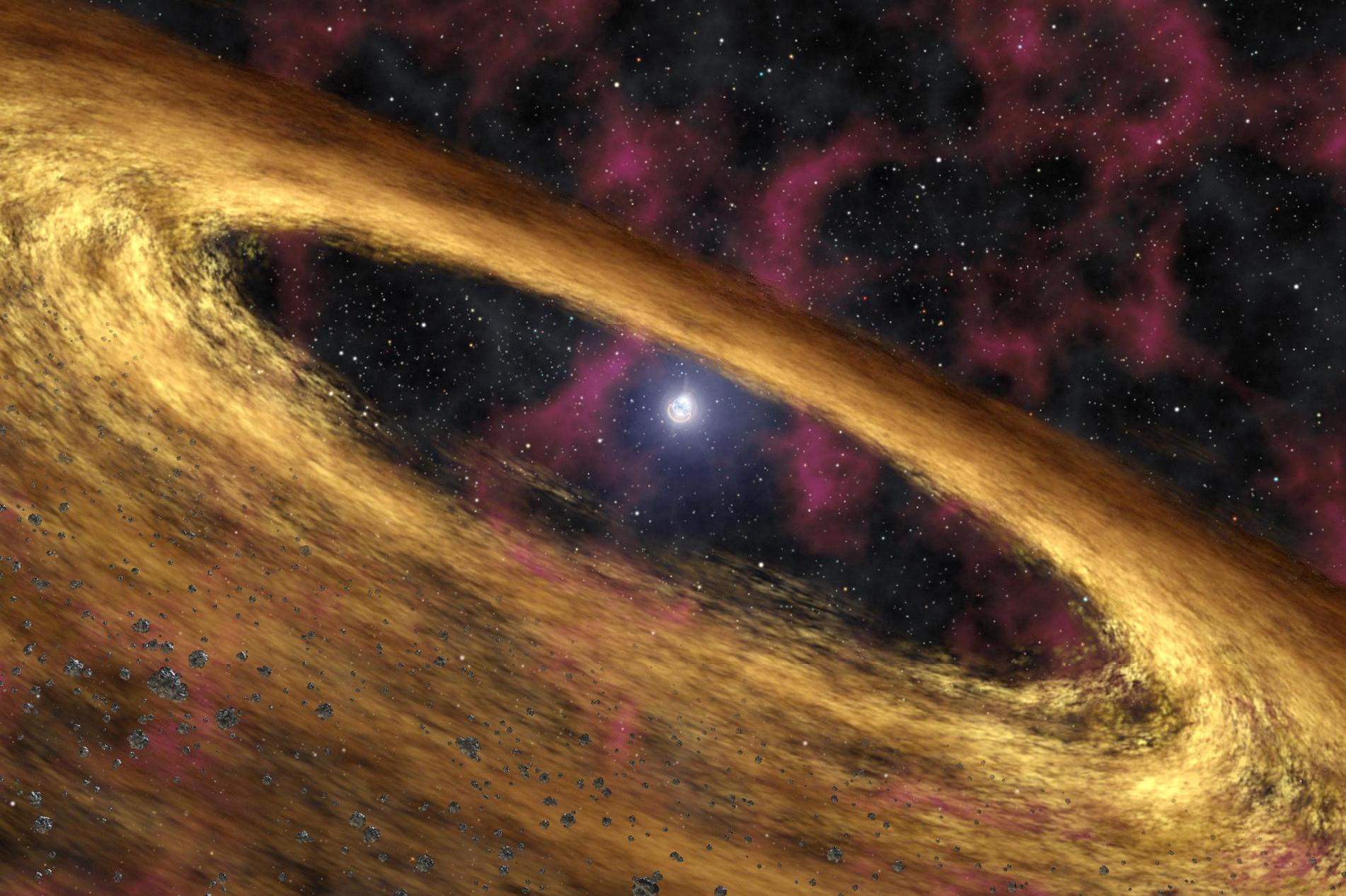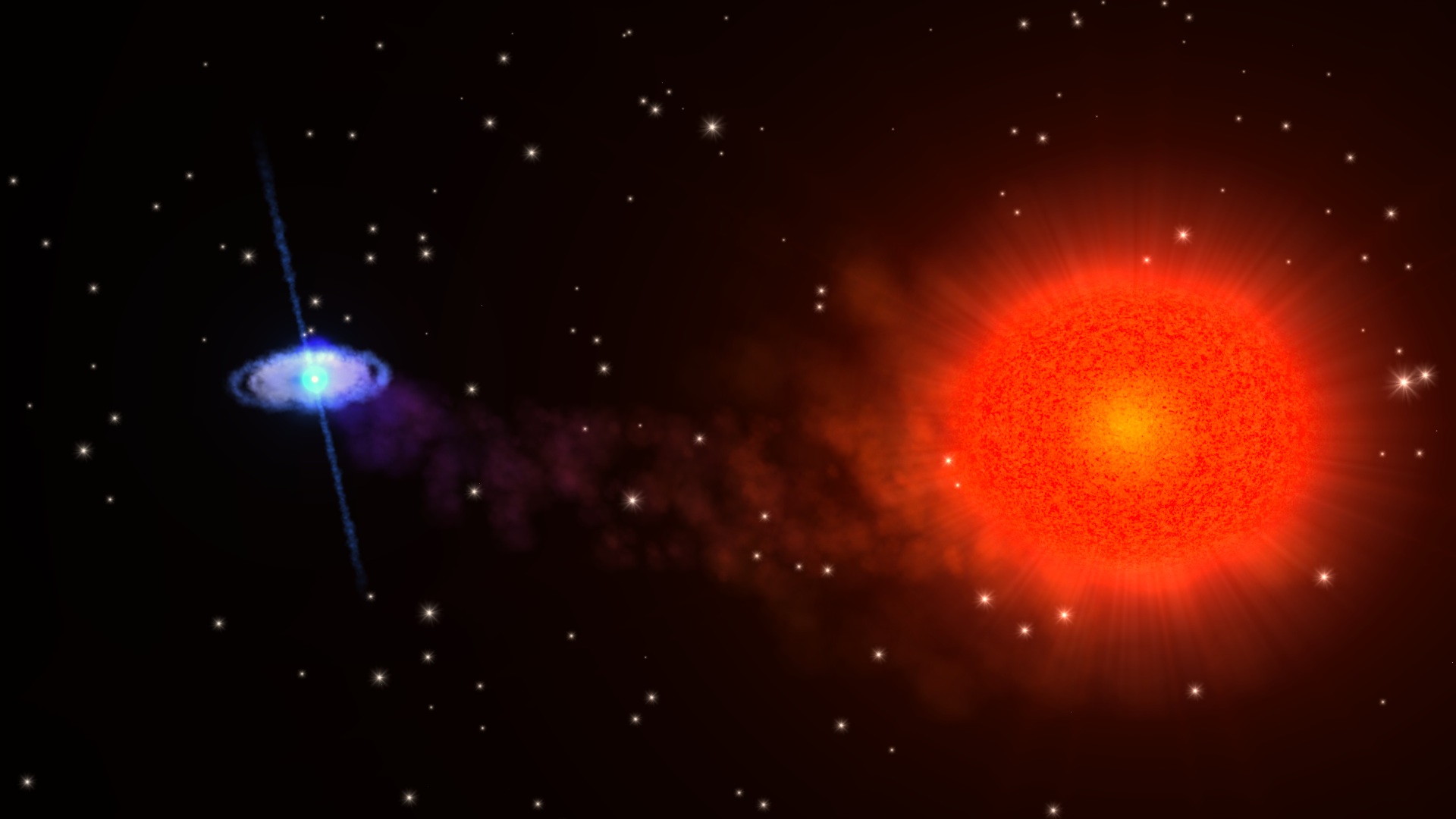Rare 'black widow' star system could help unlock the secrets of space-time
This cannibal star system could be a gravitational wave detecting machine.

Every 4 milliseconds, a dead star blasts a powerful beam of radiation toward our planet. Don't worry — Earth will be fine. It's the dead star's tiny companion that's in trouble.
In a new study published March 11 on the pre-print database arXiv, researchers describe this ill-fated binary star system — a rare class of celestial object known as a black widow pulsar. Just like the cannibal spider from which this type of system takes its name, the larger member of the pair seems intent on devouring and destroying its smaller companion. (In spiders, females are often larger than males.)
However, there will be no quick decapitation for this black widow; the larger star appears to be killing its partner much more slowly. Over hundreds or thousands of years, the larger star has sucked in matter from the smaller star's vicinity, while simultaneously blasting the small star with strobing beams of energy, which push even more matter away into space.
Someday, it's possible that the larger star could devour the smaller one completely, lead study author Emma van der Wateren, a doctoral student at the Netherlands Institute for Radio Astronomy (ASTRON), told Live Science. But, before then, scientists hope to put this strange system to work. By monitoring the larger star's remarkably steady pulses for sudden irregularities, the study authors hope this pulsar could help them detect rare ripples in the fabric of space-time known as gravitational waves.
"To detect gravitational waves, you need many, many very stable pulsars," van der Wateren said. "And unlike earlier black widow pulsars that have been discovered, this system is very stable."
Cannibal corpses
Scientists discovered star system J0610−2100 about 10,000 light-years from Earth in 2003, when they noticed its periodic pulsing with a radio telescope. Researchers pegged the system for a pulsar — a type of small, dense, collapsed star that rotates extremely quickly.
These dead stars are highly magnetized, blasting beams of electromagnetic radiation out of their poles as they spin. When one of those beams points toward Earth, the effect is like a lighthouse, with the light blinking on and off as the beam strobes past us. If the light blinks once every 10 milliseconds or less (like J0610−2100, which blinks every 3.8 milliseconds), then the star fits into an even rarer category, called a millisecond pulsar.
Get the world’s most fascinating discoveries delivered straight to your inbox.
Many millisecond pulsars share their orbits with sun-like companion stars, which the pulsars slowly devour. As the pulsars gobble up the spinning disks of matter spewed by the companion star, they glow in X-ray radiation that can be spotted across the galaxy.
And sometimes, a pulsar may take more than its fair share of matter from its companion. If a pulsar's companion star has a mass smaller than one-tenth the mass of Earth's sun, then that star system is called a black widow pulsar.
J0610−2100 was the third black widow pulsar ever detected — and seems to be one of the hungriest. The pulsar's companion star measures just 0.02 solar masses, and completes an orbit around the pulsar every seven hours or so, the study found.
For their new paper, van der Wateren and her colleagues analyzed 16 years' worth of radio telescope data from this cannibal star system. While the system is unmistakably a black widow pulsar, the team was surprised to find that it was missing a few signature quirks.
For example, the star system never showed what's known as a radio eclipse — a nearly universal phenomenon in other black widow pulsars.
"Typically, for a portion of the binary orbit, the radio emissions from the pulsar completely disappear," van der Wateren said. "This occurs when the companion star moves close to the front of the pulsar, and all this irradiated material coming off of the companion eclipses the pulse emission from the pulsar."
Over 16 years, the star system also never showed any timing irregularities — sudden, tiny differences in the timing of a pulsar's pulse compared to astronomers' predictions.
Waves that move the universe
The absence of these two common phenomena is hard to explain, van der Wateren said. It could be that the line of sight on this pulsar is skewed so that radio eclipses just aren't apparent to Earth-based telescopes, or perhaps the pulsar's companion star isn't being irradiated quite as strongly as other known pulsars that show these features. But whatever the case, this black widow system is incredibly stable and predictable — which makes it a perfect candidate for detecting gravitational waves, the researchers said.
These waves (first predicted by Albert Einstein) occur when the universe's most massive objects interact — like when black holes or neutron stars collide. The waves ripple through time and space at light-speed, warping the fabric of the universe as they pass.
One way that astronomers hope to detect gravitational waves is by monitoring dozens of millisecond pulsars at once using systems called pulsar timing arrays. If every pulsar in the array suddenly experienced a timing irregularity around the same time, that could be evidence that something massive, like a gravitational wave, disrupted their pulses on the way to Earth.
"We have not detected gravitational waves in this way yet," van der Wateren said. "But I think we are coming close.
That's what makes the discovery of highly predictable black widow pulsars like this one so important, van der Wateren added.
Typically too temperamental because of their radio eclipses and timing irregularities, black widow pulsars are rarely good candidates for gravitational wave detection. But J0610−2100 might be an exception — and its mere existence suggests that there could be other suitable exceptions out there too. Like its arachnid namesake, this black widow's cannibal bite may serve a greater purpose in the end.
Originally published on Live Science.

Brandon is the space / physics editor at Live Science. With more than 20 years of editorial experience, his writing has appeared in The Washington Post, Reader's Digest, CBS.com, the Richard Dawkins Foundation website and other outlets. He holds a bachelor's degree in creative writing from the University of Arizona, with minors in journalism and media arts. His interests include black holes, asteroids and comets, and the search for extraterrestrial life.



